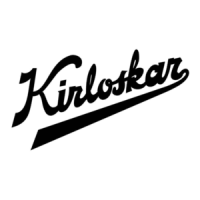and the mask should be kept at the same spot, Small
leaks can be traced with the aid of blue litmus paper,
which will fade to violet on coming into contact with
ammonia.
3.4 SAFETY RULES: FREON: (Characteristic,
Storage, Leakage)
Freon is a colourless and non-poisonous gas. When it
comes Into contact with hot surface, however, harmful
chemical reactions take place. For this reason leaks
should never be traced whilst the operator is smoking, as
the possibility exists that Freon gas may be inhaled over
the burning tobacco thus introducing poisonous gas into
the body.
The instructions given for the storage of Ammonia are
also applicable to the storage of Freon.
Freon is heavier than air and it escapes through even the
smallest aperture. As the gas is odourless, there is no
Immediate indication of possible leaks, which may
result In a serious loss of this very expensive refrigerant.
It is therefore desirable to check the plant regularly for
signs of any leakage by means of a leak detection lamp
or an electronic leak detector while trying to detect
possible leaks, the engine room should be throughly
ventilated.
It is mandatory to follow safety rules and
regulations established by local authority.
3.5 COMPRESSOR ROOM
The compressor room, where the compressor and other
machinery of the refrigerating plant are installed should
have two exits (if possible situated opposite each other)
leading to the open air. Doors, shutters and hatch covers
should be tight when shut, and open outside. The
compressor and other machinery should be easily
accessible by the attendants, who should also be able to
reach the open air without difficulty, if necessary.
The walls and ceiling of the compressor room should be
fireproof. Ventilation for the space should be fitted at
floor level (Ammonia and Freon gases are heavier than
air) and to be so arranged that any leaking gas cannot
penetrate into adjacent compartment, the local labour
safety regulations must also be observed as well as the
additional requirements of the affected insurance
company. Naked lights & fires are dangerous in spaces
where ammonia is used and therefore forbidden.
The dimension of the compressor room shall allow the
installation of equipments in favourable condition
leaving sufficient free space for service, maintenance,
operation and disassembly. Refer figure 1 and 2 of the
manual in which minimum free space required around
the compressor are given.
Compressor room must have adequate illumination
(light) to allow safe operation of controls. Also
emergency lighting system shall be provided by user in
case of normal lighting failure as well as to evacuate
plant personnel in emergency.
Ensure that noise level outside the compressor room
should not be more than 70 dB(A) sound pressure level.
If required compressor room must be provided with
acoustic insulation. Use personal safety equipment
while attending compressor room such as ear cap, safety
goggles, gloves, breathing respirator.
3.6 PREPARATION FOR COMPRESSOR
OPERATION
When a new compressor has been installed the
necessary arrangements, for its initial run must first be
made. It must be filled with oil, using the correct brand
(see lubrication chart). For renewal of the oil and
topping up during operation, refer to the same chart.
3.7 OIL CHARGING
a. Remove cover from suction oil stainer.
b. Pour oil into strainer until level slightly exceeds oil
level glass centre line.
c. Fit cover back on strainer.
d. Check that gas delivery and suction stop valves are
open.
e. Disconnect oil pressure differential pressostat if
fitted.
f. Start compressor and wait until oil return jet
becomes visible behind oil level glass.
g. After charging of refrigerant reset pressostat
referred to in set 'e' at the correct value.
h. Adjust oil pressure if necessary.
3.8OIL PRESSURE ADJUSTMENT:
The oil pressure regulator is adjusted at our works at 1.5
2
kg per cm above the gas suction pressure (on two
stage compressors above crankcase pressure). It
may occur, however, that this setting needs to be
corrected after charging the refrigerant.This should
be done as follows :
a. Check that all the gas stop valves throughout the
cooling system are open.
b. Start compressor and wait until its temperature
becomes steady.
c. Compare, on relevant pressure gauges, oil pressure
with gas suction pressure (on two stage
compressors with crankcase pressure) and
ascertain what difference exists.
d. Remove cap from oil pressure regulator.
e. With the aid of screw driver, turn slotted set pin
anticlockwise or clockwise respectively, to obtain
lower or higher oil pressure as required.
f. Adjust oil pressure regulator so that oil pressure
2
gauge indicates at least 1 kg per cm above gas
suction pressure gauge (on two stage compressors
above crankcase pressure gauge)
g. Apply screw cap back on oil pressure regulator.
3.9 PREPARATION FOR REFRIGERATING
PLANT OPERATION:
After completion of erection of a new refrigerating plant
the following procedure carried out before it can be put
into full operation.
3.10 LEAK TEST:
This test should be carried out to ensure the soundness of
all welded and other connections made during erection
of the plant on site. To carry out this test the entire
system should be filled with gas under pressure to 10 to
2
12 kg per cm . Usually this gas will be air (as dry as
possible), but for Freon plants it is preferable to use
Nitrogen. To fill the plant the use of an air compressor or
bottles, charges with air or nitrogen, is recommended.
CAUTION
10

